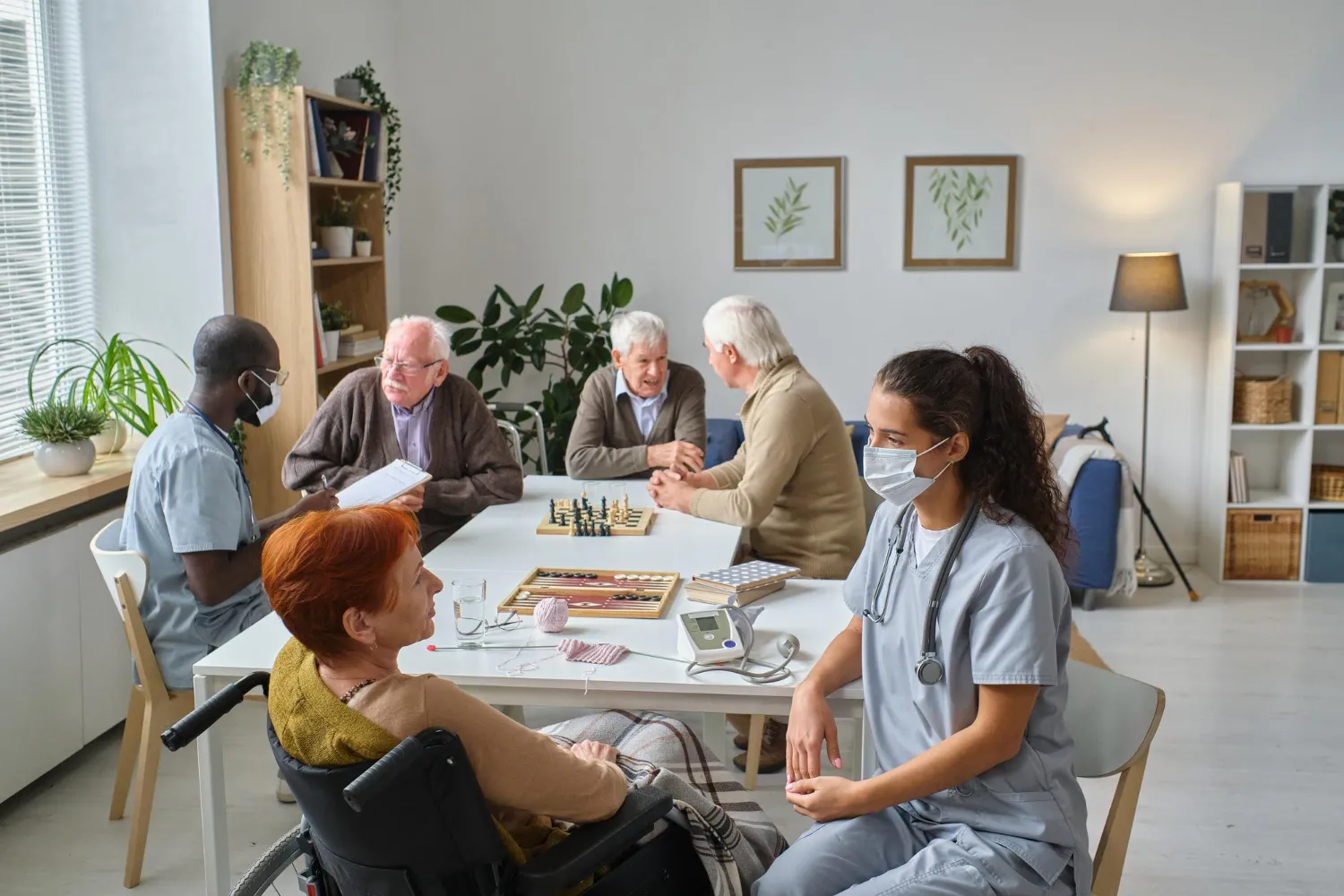A move to senior living communities can bring safety, routine, and help with daily tasks. It can also leave a parent feeling lonely. Loneliness is how someone feels on the inside. Social isolation is about the number of contacts and activities. Both affect health.
The U.S. Surgeon General reports that weak social connection can raise the risk of early death as much as smoking up to 15 cigarettes a day. It also links to a 29 percent higher risk of heart disease and a 32 percent higher risk of stroke. These are strong reasons to act early.
The setting plays a role. Nursing home studies show high rates of feelings of loneliness, near 40 percent in some research. Assisted living is not the same as nursing home care, yet many residents still report feeling alone at times. This tells us that buildings and calendars do not fix connection on their own. Families still matter to combat loneliness.
Spot Early Signs of Social Isolation Among Seniors
Pay close attention in the first weeks after a move and after any health change. Signs include comments about feeling left out, loneliness and isolation, a flat mood, tension or worry, sleeping more during the day, eating less, skipping activities, or watching more TV.
Ask simple, direct questions. Try, “Do you feel you lack companionship right now?” and “Which part of the day feels longest?” Write the answers in a small notebook and check again in two weeks.
Escalate when needed. If low mood lasts most days for two weeks, or if you notice confusion, new memory problems, or talk about self-harm, contact the care team at once. Make a same-week plan with the nurse, social worker, or primary care clinician. The health risks of weak social ties are real, so timely action helps.
Build A Simple Connection Plan With The Facility

Schedule a short meeting with the nurse and life enrichment lead. Share your parent’s interests, history, and best times of day. Ask about small groups, music hours, faith services, fitness, art, and resident councils.
Together, set two or three clear goals. Examples: attend music hour twice a week, sit at the same lunch table on Mondays, or take a 10-minute walk with a neighbor after dinner. Keep goals small. Review them monthly.
Agree on check-ins. Ask staff to note attendance and mood in a few words. Request one call each month to discuss what works and what does not. Offer to handle small barriers that staff point out, such as hearing aid batteries, glasses, shoe fit, or transport. Small fixes can unlock social energy.
Make Visits Count to Reduce Loneliness Among Parents
Quality beats length. A focused 30-minute visit often does more than a distracted two-hour drop-in. Plan one simple shared activity.
You can look through old photos, enjoy a favorite snack, do a short walk, read a sports recap, or play a quick card game. Invite a grandchild or friend at times, as the space allows. If faith is important, ask about on-site services or ride options to local services.
Set a steady rhythm. Pick a clear pattern you can keep, such as Sunday afternoons or the first Saturday of each month. If you live nearby, add micro-visits. A 10-minute hello on a weekday can lift a whole day.
Keep Contact Strong Between Visits
Phone and video help when you set a routine. Book two short calls each week. It can help to reduce isolation and loneliness in many seniors who are living alone and have less social activities.
Use simple questions and share one story from your day. Reviews of technology-based programs suggest that telephone and video contact, when supported and kept regular, can reduce loneliness for older adults, including those in long-term care.
Printed mail still reaches many older adults well. Even as tech use rises, not all seniors rely on apps or broadband.
Pew Research Center shows that 76 percent of adults 65 and older own a smartphone, which is lower than younger age groups. A mix of print and digital gives you the best reach.
Hug Letters Brings Family Stories To Assisted Living Communities
.BgE0RUEB_2pJWdE.webp)
Hug Letters is a monthly family newspaper that warms grandparents’ hearts. Each month, your parent receives a printed family journal filled with photos and short stories from the whole family. More than 1,000 families use it today. It works in three simple steps.
First, during the month, family members upload photos and two-sentence stories in the app. Second, the Hug Letters team creates and prints the journal and handles mailing. Third, at the beginning of the month, your parent finds the newspaper in the mailbox. They can hold it, reread it, and share it with friends at meals or activities.
Why This Format Helps?
It adds a steady, predictable touchpoint. It includes faces and news from everyone, not just one person. It works well for residents who do not use screens or who forget passwords. It also acts as a cue for conversation.
Staff can use it during coffee hours, and you can use it during visits. Save each issue in a binder to build a family archive over the year.
How to weave Hug Letters into your plan: assign one person each week to gather two photos, another to write brief captions, and a third to check addresses.
Ask the facility to place the paper where your parent can reach it. Put the next delivery date on your parent’s wall calendar. During visits, ask about one picture at a time and listen to the story it brings out.
Remove Barriers That Block Connection
Start with hearing and vision. Book hearing and vision checks, and replace batteries and clean devices on a set schedule. Poor hearing or eyesight can make group time feel hard or awkward. Review pain and sleep plan with the nurse. Poor sleep and untreated pain drain energy and reduce interest in activities, ultimately decreasing social interaction.
Address mobility. Ask for a dining seat near friends or near exits if walking is hard. Check for simple mobility aids that fit your parent’s needs. Reserve a spot on the community shuttle for off-site events. Small supports often make a big difference.
Right-size the technology. If your parent likes a tablet or phone, set up a clean home screen with one-tap buttons for family calls. If screens cause stress, keep using print. The goal is easy contact, not new gadgets for their own sake.
Create A Weekly And Monthly Rhythm

A steady rhythm removes friction. Here is a simple model you can copy and adjust.
Weekly:
-
Monday: A 10-minute phone check by one adult child.
-
Wednesday: A short video call with a grandchild who shares one school highlight.
-
Friday: Upload two photos and two lines to your next Hug Letters issue.
-
Weekend: One in-person visit or outdoor time, depending on weather.
Monthly:
-
Early month: Your parent receives the Hug Letters newspaper. Read it together during coffee.
-
Second week: Attend one faith service or music event.
-
Third week: Invite a neighbor to join lunch.
-
Fourth week: Review goals with staff and adjust.
Keep a simple log of mood, sleep, and attendance. Ask your parent each week to rate how connected they felt on a 1 to 5 scale. Share notes with staff. Keep what helps, replace what does not.
When Loneliness Affects Health: Talk To The Care Team
Loneliness and weak social ties raise health risks, which makes clinical follow-up important.
A 2024 study in eClinicalMedicine found that older adults who felt persistently lonely over four years had a 56 percent higher risk of stroke in the years that followed, even after the researchers accounted for depression and social isolation. Share this concern with the clinician if you see ongoing signs.
Use clinical touchpoints to screen for depression, hearing and vision loss, sleep problems, and pain. Ask for a social prescription. That might include scheduled groups, brief therapy for grief, or gentle exercise classes. The National Institute on Aging offers practical steps for staying connected, which you can adapt to your parent’s interests.
Make Visits Practical And Low Stress
Plan one concrete activity per visit. Rotate a few ideas that are easy to set up. Bring two old family photos and ask for the story behind each one. Taste seasonal fruit or a favorite candy. Read a short news piece or sports recap.
Listen to one song and talk about the memory it brings up. Keep noise low and the setting calm. If your parent lives with memory loss, choose familiar tasks and small groups.
Use the environment. Sit where your parent can see people pass by. Say hello to neighbors and staff by name. Small greetings build a sense of place. Ask staff for quieter options if hearing is a barrier, and for captions during movie nights.
Conclusion
Assisted living can make life safer and easier, yet many parents still feel lonely after the move. The fix is not complex. It depends on steady contact and small, repeatable steps. Spot the signs. Build a plan with the facility. Make visits focused. Keep contact strong between visits with calls and print.
Use Hug Letters to deliver a warm, monthly touchpoint your parent can hold and share. Remove small barriers that block connection. Track what works and adjust. Back it all with the clear message that connection supports health and mood in real, measurable ways. When you follow this path, the week feels better, and the month brings more stories, more smiles, and more life in each day.

About Martin Gouy
Martin is the founder of Hug Letters. Hug Letters is a family newsletter for grandparents. Every month, grandparents receive a heartwarming newspaper with photos and stories from the whole family.

